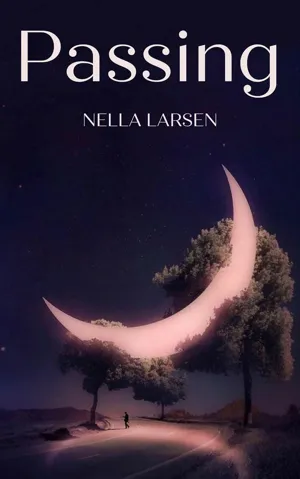Passing

Both women use 'passing' for certain advantages. One is to receive decent treatment in public. We witness this in the first scene of the novella. The two have a chance meeting in a nice hotel's cafe. They hadn't seen each other for many years and barely recognize each other, though it was Clare who made the initial approach. "Don't you recognize me?" she asks.
After meeting, Clare's husband John Bellew joins them in the top floor cafe and refers to Clare as "my nig". This inwardly horrifies Irene, but gives Clare a laugh. He explains that while he knows she's white, she seems to be getting darker every year. John even lets out the N-word a few times to drive the point uncomfortably home for the two women. Irene goes into fake laughter to cover for her old friend. It's telling scene and we can surmise how the story will unfold. As in, what should happen if John Bellew learns about his wife's ancestry?
Themes include interracial marriage and social interactions among Black people who have varying opinions on those who try to "pass". An undercurrent theme is teaching children about the realities of being Black. Larsen employs news events of the time to highlight this. One is Brian reading aloud from the newspaper about Jim Crow attrocities at the dinner table. Irene moves quickly to hush him. She wants to shield her children from those realities for as long as possible. Brian, in response, thinks they need to prepare for the real world as early as possible. But the news sticks and the boys know what's what and echo their understanding of their parents' argument.
Brian dreams of escaping the US entirely. He is weary of the racist baggage and even his patients. His dream is to move to Brazil, but stays at Irene's behest. Irene resists due to her attachment to Harlem and its people.
Irene involves herself in organizing social events and fund raisers for various causes in Harlem. She has been ignoring Clare's entreaties to meet up in numerous letters. One day Clare shows up out of the blue at her door and meets Irene's family. Clare learns Irene is organizing a dance the following evening. Clare begs for an invitation. Eventually Irene relents.
Passing as white still, Clare has a great time at the dance, spending time dancing with everyone, including Brian. She seems to have a longing for this community feeling, which is absent in her life with John. We sense a slight feeling of jealousy from Irene as she watches Clare dance with her husband.
An ambiguous ending
The final scene is yet another party, this time at a private residence. John Bellew shows up uninvited demanding where his wife is. He finally locates her near a window and I will not spoil the ending here. Another mystery readers can look for in the novella. What motives do the characters have? Who did what to whom? There's a movie of this novel on Netflix, which I'll have to check out.
Passing by Nella Larsen is one of only two novels she wrote, the other being Quicksand, apparently a more autobiographical novel also set in Harlem.